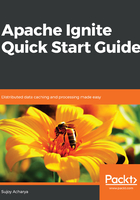
Preface
With the advent of microservice architecture, the software innovation life cycle became much faster. We are now able to build small, cohesive services that communicate with each other and be scaled and developed independently. Some of the key non-functional requirements of this style are scalability, availability, and high performance. In-memory distributed data fabrics play a key role in fulfilling these requirements.
Apache Ignite is a stable, feature rich, and distributed in-memory platform designed to scale and process large volumes of data. It can be integrated with both microservices as well as monolithic systems—and, for that matter, can also be used as a scalable, highly available, and highly performant deployment platform for microservices.
This book is a comprehensive guide that lets you explore all the advanced features and use cases of Apache Ignite, taking you through why you should explore Apache Ignite; in-memory technologies; installation and clustering of Ignite nodes; caching topologies; and various caching strategies, such as caching aside, read-through and write-through, and write-behind. You'll delve into detailed aspects of Ignite's data grid, including web session clustering and querying data. You will also obtain hands-on experience of processing large volumes of data using Compute Grid and Ignite's MapReduce and Executor Service. Furthermore, you'll gain experience with the memory architecture of Apache Ignite, monitoring memory and cache, complex event processing, event streaming, and time series prediction of opportunities and threats. Additionally, this book covers off-heap and on-heap caching, swapping, native and third-party persistence, and Spring Framework integration with Apache Ignite.
By the end of this book, you will have mastered the features of Apache Ignite 2.x and be able to build an efficient, high-performance, scalable, and high-availability system architecture.